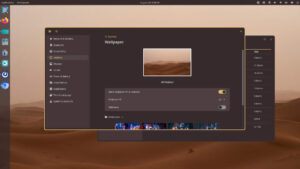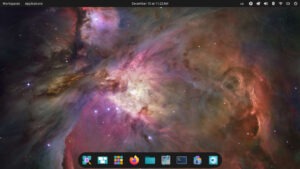About a week and a half ago, I was nearly taken-in when an item appeared on The Register that tied recent Linux desktop woes to behind the scenes moves by Microsoft to enforce patents against GNOME. Supposedly, GNOME was violating Redmond’s patented designs of the Windows 95 desktop, most specifically the Start Menu and the Start button. According to the story painted by reporter Liam Proven, KDE was also guilty of violating the same patents, but got a pass as they benefited from the famous Novel/Microsoft patent swap deal, being they were the default desktop in SUSE.
“Novell, owners of primary KDE backers SUSE, signed a patent-sharing deal with Microsoft. Xandros, at that time a significant Linux vendor on the back of Asus’ EEE, had already signed in 2006. Red Hat (still a primary sponsor of GNOME development) and Ubuntu (the leading desktop GNOME distributor) wouldn’t sign.”
According to this telling of the story, it appears as if all of the brohaha that’s ensued during the last couple of years over the much maligned GNOME 3, with it’s radically changed UI meant to redefine the desktop experience, was all brought about as a response to threats Redmond was making about the design of the “decadent” GNOME 2 interface. In other words, according to Mr. Proven, GNOME 3 wasn’t brought about because of any high-minded ideas the developers had about leading us into a brave new world of desktop interfaces. Far from it. GNOME 3 was a way to keep from being sued out of existence by Microsoft.
“In 2011, the two leading GNOME distributors both switched to new desktops. The similarities are conspicuous. Both have removed anything resembling a Start menu or taskbar, replacing some of this functionality with NeXT/Apple-like icon docks down the left hand screen edge, plus full-screen, search-driven app browsers. Both have rearranged window-title-bar buttons and Ubuntu has even banished in-window menu bars. Both have been wildly controversial and are widely disliked.”
The Register’s story was almost believable and anyone who was taken-in by this telling could certainly be forgiven. The writer played straight into the paranoid fears of many in the GNU/Linux crowd and did a good job of seamlessly integrating his tale of Microsoft misdeeds into the facts as they are known. It was easy to read this and think you were having a genuine “aha” moment. All of us, or many of us anyway, had already been scratching our heads over GNOME. Some of us were surprised when they made big changes to the UI at all, especially following the grief KDE went through several years back with the advent of KDE 4.
When the revolt of the GNOME users first began, most of us probably figured this story would play-out along predictable lines, again following a plot similar to what we’d seen during the KDE revolution. It seemed fair to expect that rather quickly the GNOME developers would find it beneficial to listen to their user base and make at least enough compromises to quell the uprising they were facing. Instead, they seemingly stubbornly stood by their plan and now the old GNOME desktop world is fragmented into pieces called Unity, Cinnamon, MATE and who knows what else.
The Register’s story would seem to explain it all. GNOME changed because they had no choice but to change. It was either redesign the GNOME desktop experience or get sued into oblivion by Microsoft. According to this telling, Red Hat and Ubuntu were behind the change, although Ubuntu bolted to develop their own Unity desktop after failing to prevail in getting their own way with the “new and improved” GNOME crowd.
It all seemed to make sense. Look at Unity with no Start button, basically copying the design of the classic Apple interface. We could now quit our head scratching. GNOME’s chain was being jerked by the evil Microsoft empire. There was a big problem with the story however, even for someone like me with no inside knowledge of what was really going on–a problem that rose a giant red flag.
Bread crumbs. There were no bread crumbs.
 The story was written as a straight ahead Associated Press or Reuters style news story. It wasn’t presented as an opinion piece or as mere conjecture. “This happended and this happened, then this happened and this happened”…except we never found out how the writer knew how anything happened. There were no links to previous articles. There were no sources quoted to back up the writer’s claims. It was like watching Bill O’Reilly. The facts have been checked. We’ve verified our sources. We don’t need to pass them on to you. This is the way it was. Take our word for it.
The story was written as a straight ahead Associated Press or Reuters style news story. It wasn’t presented as an opinion piece or as mere conjecture. “This happended and this happened, then this happened and this happened”…except we never found out how the writer knew how anything happened. There were no links to previous articles. There were no sources quoted to back up the writer’s claims. It was like watching Bill O’Reilly. The facts have been checked. We’ve verified our sources. We don’t need to pass them on to you. This is the way it was. Take our word for it.
But that’s not the way it was. Not at all. The article was just a sneaky little way of sowing some Microsoft FUD–or so it seems. The purpose of the article would seem to be to send the message that, indeed, Microsoft has enforceable patent claims against GNU/Linux; that’s why GNOME caved-in and changed their interface. If you’re a big company or an OEM, it’s not safe to put your eggs in the Linux basket. In the end, Microsoft will prevail. Funny (I don’t mean ha-ha), the story pretends to be pro-Linux. Where, I wonder, is Little Red Riding Hood in this tale?
While it’s true that Microsoft was still making FUD noises about Linux violating Redmond patents at the time, there was never any indication that any of these patents were specifically related to any desktop GUI. Indeed, we didn’t and still don’t know what the patents cover or if they even exist. The cry from the Linux development people was, “Show us the patents we’re violating so we can fix the situation.”
Again, there are no sources for the information found in The Register’s story, and my research has been unable to uncover any facts to support their claims. Usually The Register can be counted upon to get their facts straight. In this case, however, it seems as if they’ve posted an article that was pure fiction–and one that played right into Microsoft’s hands.
Editor’s note: Post updated 6/13/13 at approximately 3:45 pm to remove actuality. Source possibly misrepresented.
Christine Hall has been a journalist since 1971. In 2001, she began writing a weekly consumer computer column and started covering Linux and FOSS in 2002 after making the switch to GNU/Linux. Follow her on Twitter: @BrideOfLinux







Thanks for this article…I did read that seemingly fact based Register article. Trouble is most articles that are believably written are believed and then used a reference for other such articles, specially when they come from a popular repository of information. Real pity…
@connie new – You’re completely correct, and that was written as if it was a factual news story. It even took me in for a little bit, until I thought about it. Then I did some checking and…
You’re right. Pity.
What you are seeing here is what I call the new generation of irresponsible journalism, it’s so unfortunate that these hacks are out there spreading such bad information. We need less SJVN, Dietrich Schmitz, and Michael Larabel – and more responsible journalism.
Thanks for this article, it vindicates my decision not to follow the register.
Christine: well, thanks, I guess, for quoting me, but I did kind of think that after talking to me you wouldn’t just stop, but go get some more authoritative info from the people who know for sure. As I stated (even in the bits you quoted), I’m not a GNOME developer, I’m just a guy who was around and following the GNOME project at the time. If there had been a Shadowy Secret Conspiracy to change GNOME in response to secret Microsoft patent threats, I wouldn’t have been in on it. I cannot state authoritatively that the Reg’s story is untrue; all I can tell you for sure is that I’ve never heard any suggestion from anyone that the elements of GNOME 3’s design under discussion are in any way prompted by patent concerns, that it appears to me the author of the Reg story presents no evidence for his claims, and that a couple of the precursors to the GNOME 3 design work (the Big Board and Gimmie) certainly date to before the Microsoft patent claims in question were announced.
As I recall, in my email, I specifically suggested you talk to GNOME developers who were involved in the project at the time, including Havoc Pennington. They would be in a position to give you a straight yes/no answer, which – assuming you trust them not to lie – would presumably settle the question.
Adam, I wasn’t able to talk to anyone specifically at Gnome, though I did try, but after nearly a week I decided to go ahead with the story, as all other research indicated there was no truth to this story. I did mention in the article that you’re not a GNOME developer or connected in anyway with the GNOME project, only that you were able to watch the situation fairly closely because of your involvement with Fedora.
If you think I’ve treated you unfairly, I am certainly sorry. I have removed your quotes from the article. I appreciated your input, and did not intend for this to be a problem for you in any way.
Christine
Christine: I don’t think it’s unfair, I’m just worried about being cited as a sort of ‘definitive’ source to back up the assertion that The Reg story is absolutely untrue, when I can’t in good conscience assert that – I can only assert that I see no compelling reason to believe it’s true, which isn’t the same thing.
“I can only assert that I see no compelling reason to believe it’s true”
Adam, That’s all you asserted in the article. I took great pains when writing it to make sure that came across. I indicated that you had no inside knowledge, and made sure the quotes I used had indicators such as “that I recall” or “as I remember.” It was very clear that you were not a definitive source–just a good source.
Again, I’m sorry that this use didn’t please you. I’ve been a newspaper person for 41 years. This is the first time I’ve ever removed a quote. I respect my sources, and try to present them fairly. I take great pride in what I do, and my reputation is all I have.
Christine: sorry, I didn’t ask you to remove it, I just wanted to clarify things a bit in the comments. I agree you represented me accurately when talking about me directly, but the thing is, the story *as a whole* states quite definitively “GNOME 3, Windows 95 Disconnected”, “it seems as if they’ve posted an article that was pure fiction”, “But that’s not the way it was. Not at all. The article was just a sneaky little way of sowing some Microsoft FUD–or so it seems.”, etc etc – you don’t hedge your bets at all. And I’m the *sole* source cited. So the implication is there.
It’s clear to me. There are no limits for the GNOME team and/or GNOME fans when it comes to fabricate excuses for the disaster of GNOME3/Gnome-Shell.
I did not even bother to read the article since one of the quotes in this piece clearly shows it to be nonsense. By attributing the following to why KDE was not influenced “Novell, owners of primary KDE backers SUSE, signed a patent-sharing deal with Microsoft.”, the rest of the piece get meaningless.
It is true that OpenSUSE has changed to use KDE as default, but back around 2006 OpenSUSE had no default. You had to make a choice to continue the install process.
And more importantly, SUSE Linux Enterprise Server the commercial SUSE Linux product from Novell used Gnome as default desktop. Quite odd if Novell managed to get a patent deal covering both their own and everyone else’s use of KDE, but not a deal covering the default desktop in their key commercial offering.
@Adam This was a news analysis piece, which is my specialty, a type of op/ed–which I think is pretty clear. I’m pretty positive that no one would have thought that just because you were quoted in the article that you were endorsing my opinion. By bringing this public, I had no choice but to rewrite the piece. Otherwise, the integrity of this essay is questioned. Indeed, by bringing this public, the public perception of my integrity has already been brought into play.
Again, I’m sorry if you thought you were misrepresented. In the future, if you’re dealing with another news organization or writer, I would advise you to contact the writer privately if you have issues rather than on a public forum.
I think you’re a very good person. Honest to a T, and a very good person for Red Hat and Fedora to have around.
Sorry about that Christine, I didn’t mean to make you revise the piece, sorry that it worked out that way.
The Register story cannot be proved. Neither can yours, because Microsoft will never divilge what those patents it holds for bits and pieces in GNU/Linux are. The GNOME people won’t tell you whether they had threats from Redmond either.
The Register story is not written as a straight news piece. It is a feature – and that is specified at the start. The writer is merely interpreting several things that happened – and he does provide external links to justify his thinking – and then drawing his own conclusions.
Finally, if Adam Williamson was your main source on this story, then it has as much value as the conspiracy theories about 9/11.
Sorry, I meant “divulge”.
Oh, good lord, look who it is.
Well I don’t have any type of “journalistic license”…I’ve never written for a newspaper, college rag, or even the hometown reader so all the argument/debate over credibility and truthfulness is beyond my scope of understanding, but I will say, I enjoy the new Gnome interface extremely, and bear in mind I’m not a “fan-boy” because I also use the Unity interface in Ubuntu, the LXDE interface with openSUSE and the XFCE interface with other Linux distros, regardless of whether or not M$ tried to sue the Gnome developers they themselves (M$) are in the throes of triyng to “recover” from the disaster that is Windows 8, and even the return of the “Start” button isn’t enough to get them out of the maelstrom they have created by changing their interface, and with desktops it’s always a hit-or-miss proposition, until the public gets their hands on it and try to use it daily, you will never know how they will respond. A lof ot people didn’t like Unity when it first arrived on the scene, but now? well a lot of the nay-sayers I know who belittled it? use it regularly, the same can be said of Gnome 3.x even I myself had difficulty from the beginning, but now? it’s second nature to me, and I wouldn’t go back to the former Gnome for anything! As for M$ suing over the “Start” button, I seriously doubt they would win if they DID try, that’s the equivalent of Dell suing HP / Compaq / Asus / Acer / Gateway and any other PC maker of desktop computers for having a power button on the front! I mean while it’s asinine and ludicrous, well…..its M$ and this is what they do! I almost feel sorry for them, having to go after Free and Open Source Software, because every one else isn’t even a threat anymore!…LOL! Well this would be one “fight” they’d never REALLy win in a court of law!
Well. Microsoft does have patents related to start menus and such dating back to 3.1 I believe
http://www.google.com/patents/US5920316
…the funny thing, this would’ve been the one patent they would never use. There’s a billion different DEs available for Linux. That’s one of a myriad of reasons why Linux is fragmented and could never succeed on the desktop. Choice is great, but twenty teams all working on something different never getting together and creating one be all end all DE a’la (I think it’s called) Aqua for OSX.
@dca: While its true that having too many choices could become a nightmare, when you talk of selecting a desktop environment, most times the decision isn’t in your hands. Granted, its one thing to have a group of developers who decide they want to form some kind of union, or start a project, but in the corporate world the companies that do use Linux make their choice of desktop enterprise-wide, and usually its to avoid such prolbmes as say….someone in HR using XFCE…and someone else in Accounting using Gnome….usually the choice is made by reviewing a number of factors, ease of use, simplicity, and efficiency. I have worked at a few consulting agencies that use Linux and they have ‘standardized” their environment, and….they run smoother and with les headaches than a Windows shop! Having choice is never a bad thing for an individual…and even for companies it’s not bad, its allowing too much “freedom” of choice that can cause problems.
Please note that it’s irrelevant whether or not the patents are enforceable. What matter is that Microsoft could use its deep pockets to intimidate or bankrupt open-source developers using the always-obliging legal system as an agent.